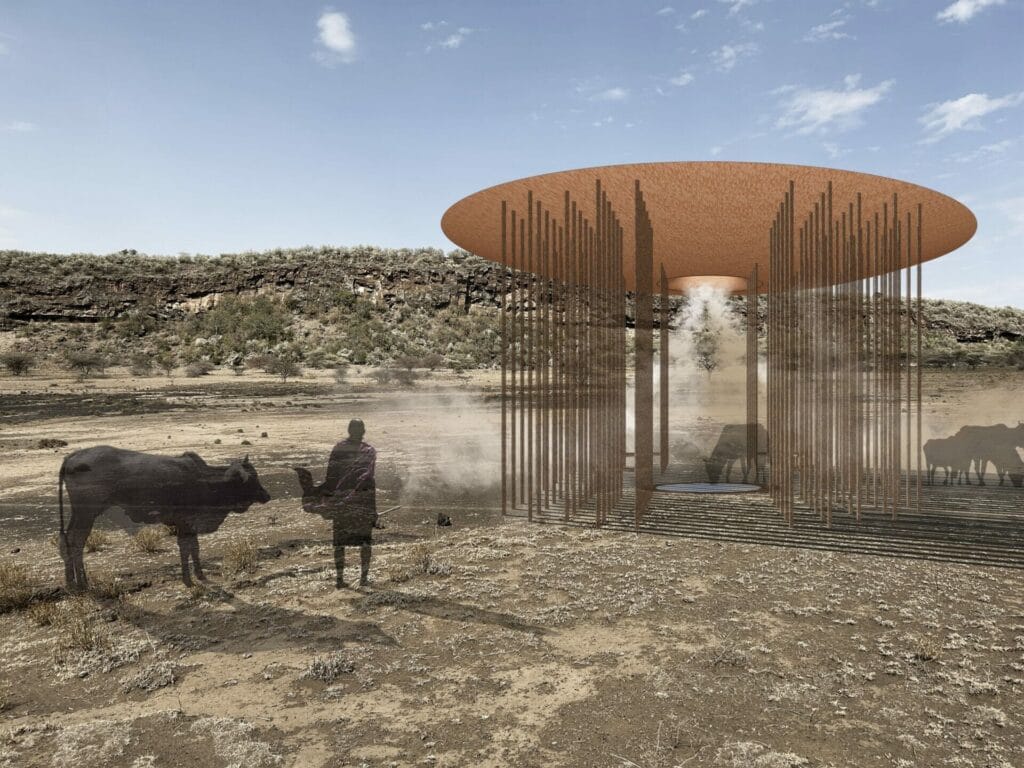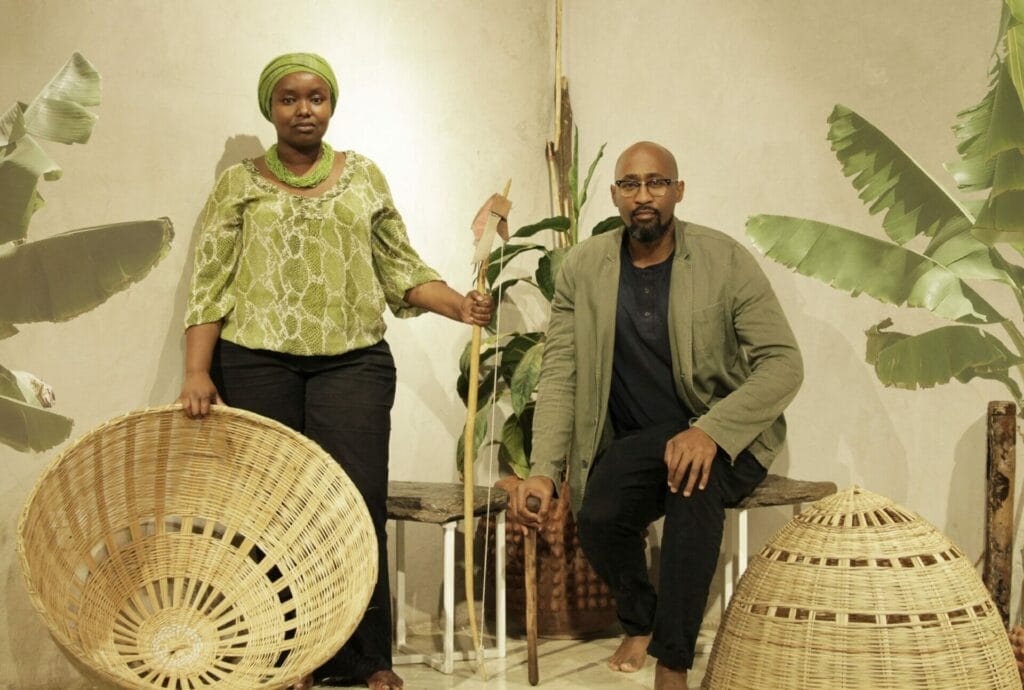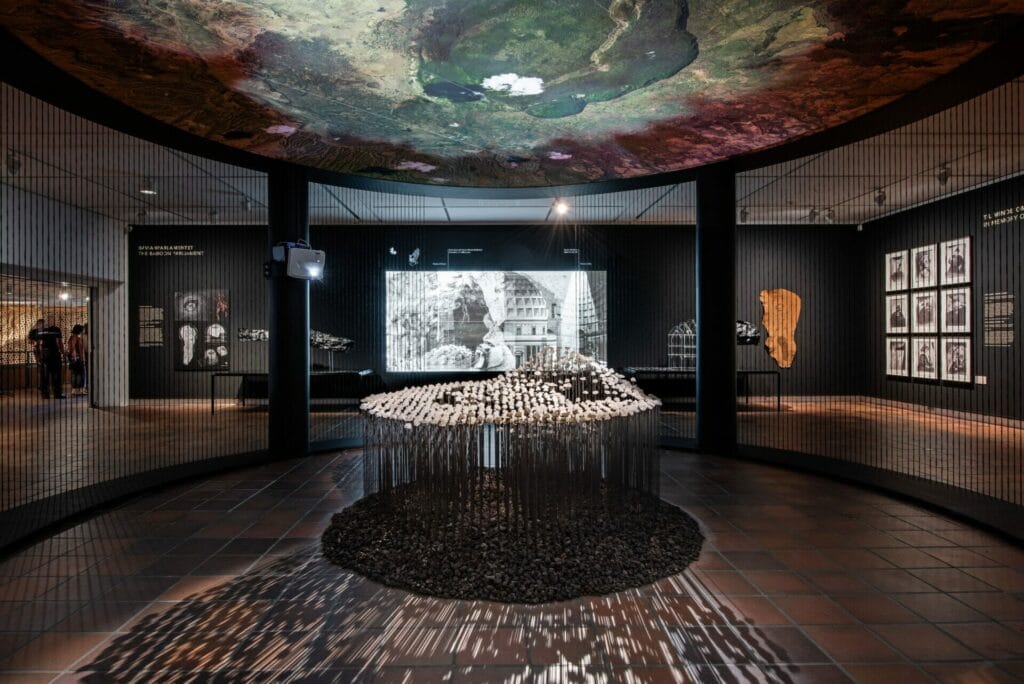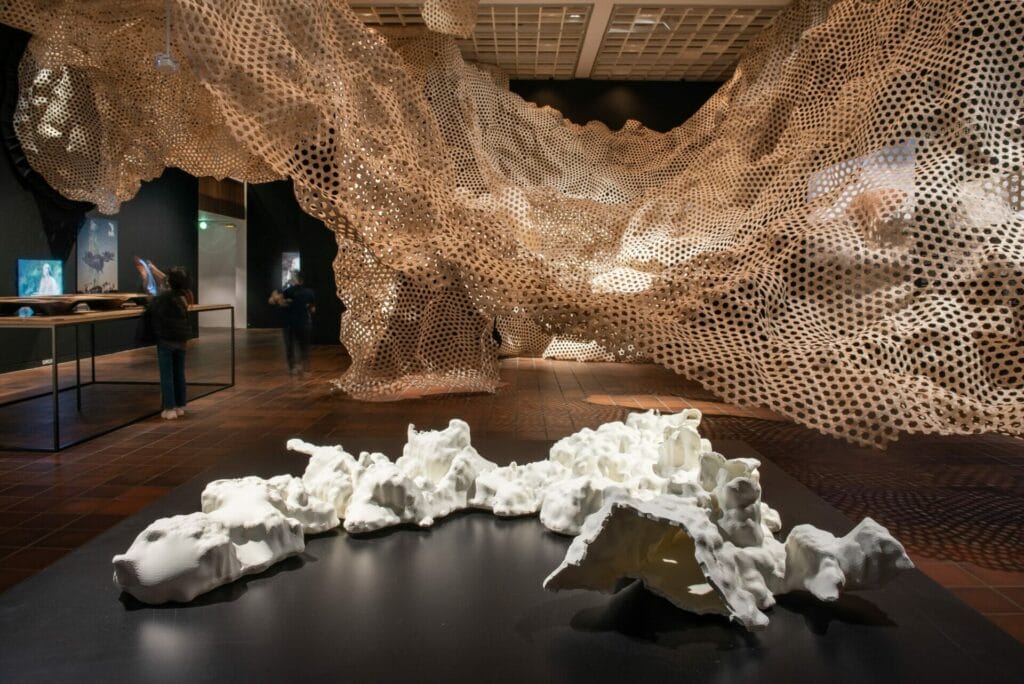The previous presentations featured in Louisiana’s Architect’s Studio series gave visitors the opportunity to enjoy a behind the scenes glimpse of architecture firms and architects in the pre-construction process. This time, we are there from the outset starting with the definition of the values on which Cave_bureau base their work as architects. We are brought back a million years in time to the landscapes that formed the setting for the origins of humankind, before proceeding to other later events that partly paved the way for the time of upheaval in which we live to day the Anthropocene.
Cave_Bureau base their work on millions of years old volcanic caves around Nairobi, which contain important testimonies to Kenya’s history. This was where the first hominids lived, while during the colonial age East African slaves and freedom fighters passed through these
subterranean caves In other words, they house vital milestones in the progression of the planet to the Anthropocene the era in which humankind s influence on nature is now all too visible.

Anthropocene Museum 8.0: Nyukie Artefact, Steam Harvester, Mount Suswa, Kenya, 2023.
© Cave_bureau
Today, the area around the caves is a source of geothermal energy a crucial player in the green transition. However, the extraction of green energy has major consequences for nature, animals and humans. The indigenous peoples, including the Maasai in Kenya, are witnessing the
destruction of their homes and their coexistence with nature. The green revolution is legitimised by its positive global narrative. This makes the struggle for indigenous culture difficult, even though these groups may very well be the people who are living most sustainably and consuming the lowest amount of CO 2.

Antropocene Museum 4.0, Maasai Cow Corridor’ (rendering), 2021
© Cave_bureau
In collaboration with indigenous peoples, anthropologists and geologists, and in their films and architectural projects, Cave_bureau seek to reveal the inequality that inextricably accompanies green energy transition. All their projects, under the umbrella title The Anthropocene Museum are also an attempt to formulate the foundation on which their practice as young African architects should be based. To avoid repeating the oppression of Africa n peoples by history, we need to listen to their voices as we build the towns, cities and communities of tomorrow. Cave_bureau was founded in 2014 by architects Kabage Karanja and Stella Mutegi.

Kabage Karanja & Stella Mutegi
Foto: Cave_bureau
The Door of No Return
The entrance to the exhibition is a version of the gate through which West African slaves passed before departing by ship. A number of these slaves were shipped to the Danish West Indies. In the exhibition, the architects have enlarged this gate The Door of No Return and transformed it into an installation of limestone stalactites. Limestone can be found in the Shimoni Cave in eastern Kenya, but the stones for this installation came from the limestone quarries in Faxe, Denmark The gate invites us to travel back in time in the company of Cave_bureau.

Foto: Louisiana Museum of Modern Art / Kim Hansen
The first room of the exhibition features a number of Anthropocene Museum projects. On display are analytical surveys, interviews, installations, discussions and conversations presented in short films. There is also a collection of objects that have an impact on Kenya s cultural and natural history all of which form the basis for Cave_bureau s activist architecture.

Anthropocene Museum 3.0: Obsidian Rain Mbai Caves, Nairobi, Kambu County, Nairobi, Kenya and the 17th Venice Bienale of Architecture, 2021. Exhibition, installation, bronze models, leather drawings, newspaper publication (New York Times online).
Foto: Francesco Galli
The same room contains a Cave_bureau installation about the geological events that shaped the volcanic caves, featuring models that inscribe the caves in the history of architecture like the architecture that the very first people knew. According to Cave_bureau, knowledge of geology which is still shaping our world and consequently our architecture should form the very foundation for the architecture of tomorrow.
Cow Corridor
The third section of the exhibition shows projects that are directly derived from the architecture of the caves. Cow Corridor is a restoration of Maasai grazing routes through Nairobi, which have been closed for pastoral migration since the advent of the British in 1880. Cave_bureau 3D scans the caves and uses the complex spaces as a model for new, site specific architecture.

Cow Corridor collage
The Cow Corridor is developed on a reversed 3D scan of the Shimoni Slave Caves
© Cave_bureau

Cow Corridor collages.
The Cow Corridor is intended to stretch from the Jomo Kenyatta Interantional Airport reserve land, right into Nairobi’s derelict railway yards, underutilised road reserves and riparian areas.
© Cave_bureau
Cave woven in rattan
At Louisiana, the Shimoni Cave, located on the shores of the Indian Ocean, has been transformed into a woven rattan structure an ambitious, full size attempt to reproduce the spatiality and materiality of the caves. Inspired by precolonial craftsmanship and building techniques, the woven work is the result of a collaboration with CITA The Centre for Information Technology and Architecture at the Royal Danish Academy Architecture, Design Conservation in Copenhagen. The latter devised a programme to transform shape into a weaving pattern. Under the direction of Jack Young, PhD and Professor Phil Ayres, the installation has been handwoven at Louisiana.

Foto: Louisiana Museum of Modern Art / Kim Hansen
Exhibitions in the series The Architect s Studio
Opening in 2017, the first exhibition in The Architect s Studio series presented Amateur Architecture Studio in China, headed by Wang Shu and Lu Wenyu. The following year s exhibition, So Far featured Chilean architect Alejandro Aravena and the Elemental studio. In 2019, the series showcased Mexican architect Tatiana Bilbao, and in 2020 21 Indian architect Anupama Kundoo. In 2022, the fifth inst alment in the series presented Forensic Architecture s work to uncover, map and submit evidence of conflicts and crimes around the world.
Louisiana’s architecture exhibitions are supported by Realdania, a philanthropic association.
THE ARCHITECT’S STUDIO: CAVE_BUREAU is organized by curator Kjeld Kjeldsen and curator Mette Marie Kallehauge.
Catalogue: To accompany the exhibition, Louisiana has published a richly illustrated catalogue with an introduction by Mette Marie Kallehauge, Kjeld Kjeldsen and Poul Erik Tøjner, together with articles by Kabage Karanja, Stella Mutegi, András Szántó, Mark Williams, Jan Zalasiewicz, Molly Desorgher, Kathryn Yusoff, Joy Mboya, Ngaire Blankenberg and Lesley Lokko.
